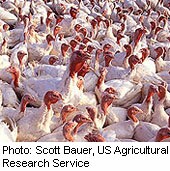
THURSDAY, April 25 (HealthDay News) — A new study is the first to confirm that the H7N9 bird flu virus is passed from birds to people. But the study did not find evidence of person-to-person transmission.
In the study, Chinese scientists provide details about four cases of human H7N9 infection in the eastern Zhejiang province. All four patients had been exposed to poultry, either through their jobs or by visiting poultry markets.
The study authors tested samples taken from 20 chickens, four quails, five pigeons and 57 ducks at six poultry markets where the patients were likely to have been. Two of the five pigeons and four of the 20 chickens tested positive for H7N9, but the virus was not found in any of the ducks or quails tested.
Then researchers analyzed the genetic makeup of H7N9 viruses from one of the patients and one of the chickens and found similarities between the viruses, confirming that the H7N9 virus can be transmitted from poultry to people, according to the study published online April 25 in The Lancet.
The scientists also tracked 385 family members, co-workers and health care staff who had unprotected contact with the patients. None of them showed any symptoms of H7N9 infection over 14 days of follow-up, which suggests that the virus currently cannot be spread among people.
However, there is evidence that the H7N9 virus has developed some genetic characteristics that adapt it specifically to infection in mammals. Further genetic changes might enable the virus to be transmitted from person-to-person, the researchers noted.
“Overall, the evidence, in terms of epidemiology and virology, suggests that it is a pure poultry-to-human transmission, and that controlling [the epidemic in humans] will therefore depend on controlling the epidemic in poultry,” study co-lead author Kwok-Yung Yuen, of the University of Hong Kong, said in a Lancet news release.
That would include measures such as temporary closure of live bird markets, comprehensive programs of surveillance, culling and segregation of poultry species, and possibly vaccination of poultry.
World Health Organization (WHO) officials said Wednesday that they are concerned about the ability of the H7N9 virus to jump from birds to humans and to infect birds without causing obvious symptoms, according to the Associated Press.
“This is definitely one of the most lethal influenza viruses we have seen so far,” Dr. Keiji Fukuda, the top influenza expert at WHO, said during a briefing in Beijing. However, a large number of milder cases may also be going undetected, he added. WHO officials investigated the H7N9 cases with Chinese authorities this week, the AP reported.
More than 100 people in China have been infected with the H7N9 virus, with most getting seriously sick and more than 20 dying, the AP noted. The first case in Taiwan was confirmed on Wednesday, a 53-year-old man who became sick after returning from a visit to the eastern Chinese province of Jiangsu.
More information
The U.S. Centers for Disease Control and Prevention has more about the H7N9 virus.

